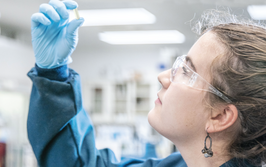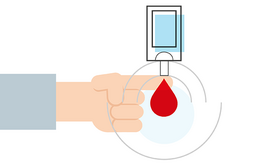
Tiny Dancers
Could observation of waltzing therapeutic nanoparticles help determine drug efficacy?
By nature, the process of drug delivery is sensitive. The binding of a ligand at a cell receptor is akin to a dancer selecting a partner. A fine-tuned affinity is required for the partnership to work; binding that is too strong or weak can result in a failed interaction. The successful delivery of immunotherapies is a constant challenge, as is the ability to detect ligand-receptor interactions at a high resolution when trying to select the most effective immunotherapies.
Researchers at Indiana University have observed the rotation of drug delivery particles, providing detailed insights into binding at receptor sites (1). And, though the group has not delivered drugs into cells in this study, they hope their technique of detecting particle binding to receptors on cells will one day enable better screening of drug carriers with desirable properties.
“Conventionally, people have always thought that when particles bind to ligands, they will slow down and become ‘trapped.’ What they see is the translational motion of that particular particle,” explains Yan Yu, an assistant professor at the Indiana University Bloomington College of Arts and Sciences.
Yu and her colleagues developed a technique that employs pairs of colored nanoparticles. In each particle pair, the dancing partner has a 200-nm green nanoparticle with a 40-nm red nanoparticle attached on the surface. By differentiating the particles with color, the waltz-like motion of the particle pairs (which begins with random rotation, transitions into a rocking motion, and then finally becomes confined to a circling motion) could be captured. “By measuring the rotation of these particles, we can garner more detail about how strongly these molecules bind to receptors. And this will allow us to screen molecules to discern which among them have the best binding to targeted receptor sites,” explains Yu.
The researchers camouflaged the particles they used in their investigation. The particles were coated in cell membranes derived from T lymphocytes – which could make them good drug delivery vehicles. Yu’s team also found that the particles were able to stay in circulation for longer periods than cells lacking the T-lymphocyte derived cell-membrane coating. Yu and her colleagues will now be using the imaging technique to investigate how their synthetic particles enter and bind to target cells during the drug delivery process.
- Yan Yu et al., “Waltz of Cell Membrane-Coated Nanoparticles on Lipid Bilayers: Tracking Single Particle Rotation in Ligand–Receptor Binding,” ACS Nano, 12, 11871–11880 (2018).
After finishing my degree, I envisioned a career in science communications. However, life took an unexpected turn and I ended up teaching abroad. Though the experience was amazing and I learned a great deal from it, I jumped at the opportunity to work for Texere. I'm excited to see where this new journey takes me!


















